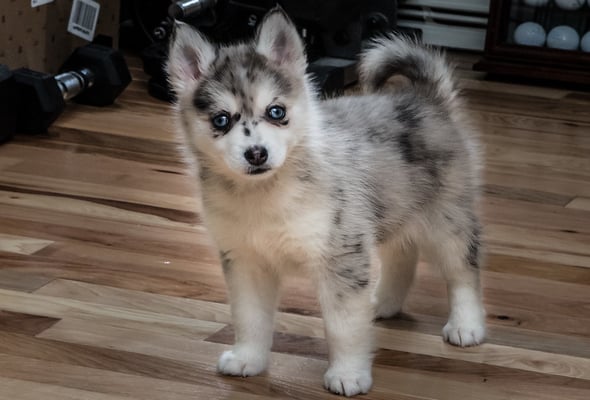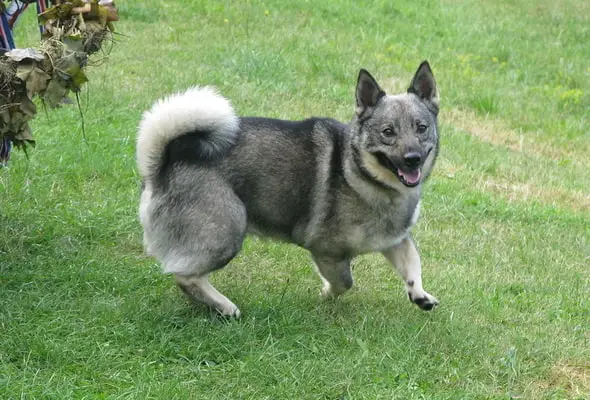While we all may be able to appreciate the majestic and powerful appearance of Huskies, the breed certainly isn’t for everyone.
To begin with, Huskies require a good deal of indoor and outdoor space, as well as vigorous daily exercise.
Their heavy coat and large body size also make them poorly adapted for heat and urban environments, and they tend to fare better in cooler climates that see a good amount of snowfall. This makes sense, seeing as the breed was developed to live and work outside in freezing temperatures.
However, for those who can’t seem to get the thought of owning a Husky out of their heads, there are a couple of small dogs that look like huskies out there that are pretty darn close to Huskies in appearance, but that are far easier to keep and are much less demanding than an actual Husky.
The 2 Small Dogs That Look Like Huskies
One way that people have gotten around the Husky’s demanding upkeep and environmental requirements is by shrinking the breed in size. Needless to say, smaller dogs can be kept in more confined environments and have an easier time regulating internal body temperature. Exercising a small dog also tends to require less space.
One of the easiest ways to preserve a breed’s appearance while decreasing its overall size is by crossing it with a related breed with the desired characteristics.
1. Pomsky

Average Lifespan: 12-15 years
Adult Size: 15-25 pounds
Coat: layered, long
The Pomsky, a portmanteau of Husky and Pomeranian, is a designer dog breed that’s a hybrid of a Siberian Husky and Pomeranian. Both dogs belong to the Spitz-type, and so already share some features. This includes the length of fur, body shape, and facial structure.
Because these two breeds are distantly related, the odds of creating a hybrid that preserves the appearance of one of the breeds while shrinking the overall size of the dog are relatively high.
Given its hybrid nature, the Pomsky is not actually a distinct or true breed, meaning it will likely have one parent that’s a Pomeranian and the other a Husky.
This can actually be a plus in terms of the health of your dog, as each parent will have fewer overlapping genes, lessening the odds of serious health issues. However, because the dog is a hybrid, it may be harder to find and more expensive.
Why a Pomsky?
For starters, as we mentioned earlier, the Pomsky is a smaller breed which shares select features with its parents.
As you can see from the photograph above, the Pomsky is strikingly similar in appearance to a Husky, albeit much smaller. Owners have commented that having a Pomsky is like having a Husky that never grew past its puppy-phase.
With its smaller size comes the immediate benefit of requiring less space. Like Pomeranians, the Pomsky does well in indoor environments and is well adapted to apartment life. However, because it is larger and more muscular than a Pomeranian, it may still require a moderate amount of physical activity.
Also like its Husky cousins, the Pomsky is known for being an intelligent and perceptive dog that responds well to training. Due to its hybrid nature, individuals may vary more widely in this regard.
Lastly, the Pomsky retains the thick coat of the Husky and is therefore a dog that can appreciate a romp in the snow. While Pomskies fare well in cold environments, they can definitely handle hotter temperatures than their Husky counterparts.
That said, Pomskies do not enjoy very hot weather, and, as a dog with a thick coat, you should remain cautious when exposing your Pomsky to heat. Overall, they’re one of the most popular small dogs that look like huskies.
2. Swedish Vallhund

Average Lifespan: 12-15
Average Size: 15-30 pounds
Coat: medium, dense
As the name suggests, the Swedish Vallhund is a spitz-type breed that originally hails from Sweden, where it was bred as a herding dog and watchdog capable of coping with icy temperatures.
The breed is considered quite old, and has been around for over a thousand years. It is thought the Swedish Vallhund was used to breed the Corgi.
Unlike the Pomsky, the Swedish Vallhund is not a hybrid, and its similarity to the Husky is due to the fact that both dogs were bred for cold weather environments, and therefore were bred for features that are advantageous in similar settings.
Because of this, the Swedish Vallhund does have slightly more demanding exercise requirements, seeing as it is a working breed. As with the Pomsky, the Swedish Vallhund does present a more manageable alternative to a Husky.
However, the breed still comes with its own set of demands and requirements that must be met in order to keep this dog happy and healthy. As a working dog, the Vallhund should be exercised regularly.
Although it does well in the cold, its short legs make it poorly equipped for deep snow, where it can struggle to keep up and above the snow drifts.
Why a Swedish Vallhund?
Intelligent, active, and fiercely loyal, the Swedish Vallhund makes for a dedicated and loyal companion that can handle rough play and can hold its own around grabby children. For a smaller dog, the Vallhund is quite sturdy and resilient.
Another, not immediately obvious, reason for keeping a Swedish Vallhund is the preservation of this ancient breed. Despite being the national dog breed of Sweden, the Vallhund came close to extinction in the mid 20th century. Nowadays, the breed is still fairly rare, but has recovered somewhat in number.
Overall the breed is known to be healthy and suffers only a few genetic health issues, making it a breed that’s long-lived.
Like other herding breeds, the Swedish Vallhund is incredibly receptive to training and is known to do well in dog agility competitions. Keeping this dog mentally engaged and stimulated is definitely something to consider.
While it does superficially resemble a Husky, of the small dogs that look like Huskies this breed has its own unique personality and characteristics that distinguish it from its more popular doppelganger, and is worth having in its own right.

